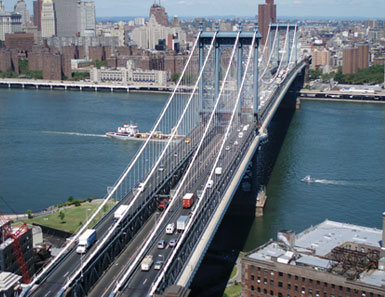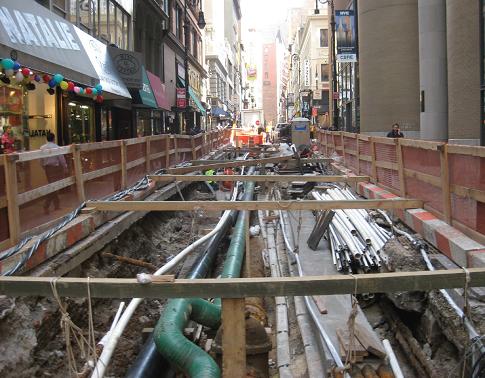3.5.1 Holds
A hold is a "do not release" order that can be placed on permits or permittees to prevent the permit from being processed. Any given permit or permittee may be subject to one or more holds. Contact information pertaining to the release of holds by NYC DOT can be found in Appendix C, NYC DOT Contact Information.
Permit Office and OCMC Holds
Capital Project In-House (CPI) hold — A CPI hold is automatically placed if the proposed permit location involves a street that will be resurfaced by a NYC DOT in-house resurfacing operation in the near future.
CPI holds are regularly released by the borough Administrative Superintendent of Highway Operations (ASHO) if the proposed work does not interfere with the in-house street resurfacing operation. If the hold is not released, the applicant must contact the borough ASHO to determine the feasibility of the work being completed prior to the final resurfacing. If it is determined to be unfeasible, the pending permit will be rejected.
Street Arterial Maintenance (SAM) hold — A Street Opening Permit request to perform work on a protected street will automatically have a SAM hold placed on it if the proposed work start date is within 18 months of the street being resurfaced/reconstructed. The hold is to review the proposed work and set conditions for the work and/or restoration.
To request a release of a SAM hold, the borough ASHO must be contacted to discuss the work and allow the ASHO to determine the extent of the restoration requirements.
Capital Project by Other Agency (CPO) hold — A CPO hold is automatically placed if the proposed permit location involves a current capital street reconstruction project or one that is being planned.
For New York City Department of Design and Construction (DDC) capital projects, a CPO hold can only be released by DDC. CPO holds will typically be released by DDC if the proposed work does not interfere with its schedule. If the hold is not released, the applicant must contact DDC (DDC contact information is available in Appendix D, Other Agency and Utility Contact Information).
For non-DDC capital projects, the applicant may contact the Permit Office to request release of a CPO hold.
Bridge (BOB) hold — Any planned work requiring a Building Operations/ Construction Activity Permit that may potentially be within 100 feet of a bridge structure will be placed on a Bridge hold. If any proposed work is within 100 feet of a bridge or structure, applicants must submit a scaled drawing showing the work and exact location. If the work is more than 100 feet away from the bridge structure, applicants must send a certification by e-mail stating so. Either response must be sent to NYC DOT's Division of Bridges at bridgeshold@dot.nyc.gov for review and release prior to commencing work. Emergency work will not be placed on hold and shall proceed in accordance with Highway Rules, Section 2-11 (g).
The Bridge Hold Map shows locations where Bridge holds apply.

Permit applications near bridges are subject to approval by the Division of Bridges.
Executive (EXC) hold— An EXC hold is automatically placed if the proposed permit locations involve locations deemed necessary by NYC DOT. These include major construction related projects or planned traffic enhancements (e.g., Second Avenue subway, bus rapid transit, water tunnel route), or where there are significant traffic issues (e.g., “thru” streets, exits and entrances to major tunnels and bridges).
These holds can only be released by OCMC executive staff. Once OCMC executive staff determines the final permit stipulations, the permit will be released. However, if extraordinary conditions are present, the applicant may be asked to meet with OCMC.
Full Closure Review (FCR) hold— An FCR hold is automatically placed on the 90th consecutive calendar day of any full street closure. OCMC will review the project to determine if a Community Reassessment Impact and Amelioration (CRIA) statement must be submitted to NYC DOT. A CRIA statement is required if the closure is expected to last for more than 180 consecutive calendar days, as set forth in Section 2-16 of the Highway Rules.
To release an FCR hold, the applicant must demonstrate that either he or she has begun the CRIA process or that the CRIA statement is not required. At that point, OCMC executive staff will determine if additional permit stipulations are required. If no changes are required, the permit will be released.

A Full Closure Review (FCR) hold is triggered when a street is closed for 90 days.
OCMC will release the hold after it reviews the proposed work and adds the permit stipulations.
Poles (POL) hold— A POL hold is automatically placed if the proposed permit work is for the installation of a pole on the sidewalk, which must be reviewed, approved and released by NYC DOT Street Lighting.
To release a POL hold, the Division of Traffic Operations, Office of Street Lighting must be contacted.
Vault (VLT) hold— A VLT hold is automatically placed if the proposed permit work is for the installation or repair of a vault, which must be reviewed and released by the Permit Office. To release a VLT hold, the Permit Office’s Plan Examination Unit must be contacted.
LMZ (Lower Manhattan Zone) hold – This hold signifies that you are working on a street that falls within the Lower Manhattan Zone (south of and including Canal Street). Your permit(s) must be reviewed and released by the OCMC Office.
HIQA Holds
There are two categories of HIQA holds: Holds for Specific Permit Type or Unique Street Treatment and Holds that May Be Placed on the Permittee.
These holds can only be released by HIQA:
Holds for Specific Permit Type or Unique Street Treatment
Cobblestone (COB) hold— All permits issued to work on a cobblestone street are automatically placed on hold until a HIQA inspector performs an inspection of the work site to establish existing conditions before work begins.
To request release of a COB hold, the applicant must contact the HIQA borough office in the borough in which the proposed work is to be performed to arrange for an inspector to visit the work site prior to the start of the work.
Concrete (CON) hold— All permits issued to work on concrete portions of the roadway are automatically placed on hold until a HIQA inspector performs an inspection of the work site to establish existing conditions before work begins.
To request release of a CON hold, the applicant must contact the HIQA borough office in the borough in which the proposed work is to be performed to arrange for an inspector to visit the work site prior to the start of the work.
Special Treatment Projects (STP) hold— Any permits issued to work in areas that have a special treatment such as Times Square, Madison Square, Herald Square and other pedestrian plaza areas are automatically placed on hold.
To request release of an STP hold, the applicant must contact the HIQA borough office in the borough in which the proposed work is to be performed. HIQA will determine whether an inspection of the work site is warranted to establish existing conditions before work begins.
Canopy (CAN) hold— A CAN hold is automatically placed on a canopy maintenance permit application until a HIQA inspector performs a final inspection confirming the submitted plans.
To request release of a CAN hold, the applicant must contact the HIQA borough office in the borough in which the canopy is installed to arrange for a final inspection following canopy installation.
Re-Dig (RED) hold— In cases where an inspection has revealed a failed restoration and permittees have been told to redo the entire restoration, a RED hold will be placed. A HIQA inspector must be present during the restoration.
To request release of a RED hold, the applicant must contact the HIQA borough office in the borough in which the proposed work is to be performed.
Holds that May Be Placed on the Permittee
Any of these holds will prevent a permittee from applying for new permits:
New York City Department of Finance (DOF or Finance) hold— If a permittee has failed to pay previously issued summonses/Notices of Violation (NOVs) to the New York City Environmental Control Board (ECB), all future permit requests may be placed on hold until the fees associated with the outstanding summonses/NOVs are paid. (See Chapter 4, Section 4.5 Street Construction Inspections and Enforcement regarding the circumstances in which summonses/NOVs may be issued.)
To request release of a DOF hold, the permittee must contact Finance and either make a payment or agree to a payment schedule for all fees associated with the outstanding summonses/NOVs. Once Finance contacts HIQA, the hold(s) will be released.
Revenue hold— If the permittee owes NYC DOT money for an open Corrective Action Request (CAR) or Jolt Elimination Team (JET) bill, all future permit requests may be placed on hold until the bills are paid. (See Chapter 4, Section 4.5 Street Construction Inspections and Enforcement regarding the circumstances in which CARs may be issued.)
To request release of a Revenue hold, the permittee must contact NYC DOT's Fiscal Affairs Office to arrange for payment of outstanding bills. Upon satisfactory payment, the hold(s) will be released.
Incorrect Information on File— If a permittee’s 24/7 phone number, address or other contact information is inaccurate or has changed without being updated, all future permit requests may be placed on hold until the information is updated.
To request release of the hold, the permittee must contact HIQA’s central office or one of the borough offices to update the file. Upon completion of updates, the holds will be released.
Unsafe Conditions— If the permittee has been notified and fails to address an unsafe condition, all future permit requests may be placed on hold until the unsafe condition has been eliminated.
To have the hold released, the permittee must correct the unsafe condition, and then contact HIQA to arrange for an inspection. Upon a satisfactory inspection, the hold(s) will be released.
Working Without a Permit— If the permittee has been issued a summons/NOV for working without a permit, all future permit requests may be placed on hold until the applicant takes out a permit of record for the work that was performed.
To request release of the hold, the permittee must take out a permit of record for the work that was performed without a permit and then contact HIQA to submit a copy of the permit. Upon completion of this action, the hold(s) will be released.